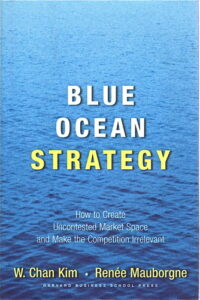Note: when I used to have my own consulting business (cleverly named Notter Consulting), I used to post book reviews periodically to my website (before blogs even!). I’ve decided to migrate them over to this blog for posterity so keep your eyes out every so often for a book review, even if the book isn’t really current (because it is still good).
 Blue Ocean Strategy: How to Create Uncontested Market Space And Make the Competition Irrelevant
Blue Ocean Strategy: How to Create Uncontested Market Space And Make the Competition Irrelevant
by W. Chan Kim and Renee Mauborgne
Harvard BUsiness School Press, 2005
Like many business authors, Kim and Mauborgne are seeking to provide a valid explanation as to why certain companies achieve significantly greater success than their industry competitors. Why is Southwest Airlines so successful in an industry replete with bankruptcies? How did Cirque du Soleil become successful in the obviously declining circus industry?
Their answer, which is compelling and well documented, is that these companies made insightful strategic moves that were intentionally not based on the moves of their competitors. They mapped out a strategy with fundamentally different assumptions than their competitors, thus moving into virtually competitor-less territory (blue oceans, as opposed the “bloody red oceans” of competitive space) and sustaining exceptional business growth.
The authors provide some useful conceptual frameworks for exploring blue ocean strategy in the context of any business, including, I would argue, nonprofit organizations (although their examples are all corporate). I particularly like the notion of a “strategy canvas” where you can plot a “value curve” for your organization and your competitors. For Blue Ocean strategy, you must radically alter the existing value curve by creating new points on the curve, as well as raising, reducing, or completely eliminating others. They provide a guide for developing blue ocean strategic moves, although it is clearly based on a product-based commercial venture.
I also like this book because it shares attention between both strategy and execution. There is an entire chapter on overcoming organizational hurdles to executing blue ocean strategy. Too often authors act as if simply coming up with the right strategy (the “answer”) is all that is needed for success. Kim and Mauborgne describe what they term “tipping point leadership” (in reference to Malcolm Gladwell’s book, The Tipping Point) that leverages small numbers of people and resources to overcome organizational barriers to implementing blue ocean strategic moves. They also stress the importance of including all parts of an organization in the development and execution of strategy for it to succeed. Ultimately, they point to the value of an organizational culture based in trust, commitment, and voluntary cooperation, although they admit you can’t do that using the traditional method of separating strategy formulation from execution: “Although this disconnect may be a hallmark of most companies’ practice, it is also a hallmark of slow and questionable implementation, and mechanical follow-through at best.” (p. 184)
This is not a generic book about strategic planning. Blue ocean strategic moves are designed specifically for high-growth ventures, and the authors admit that not all strategic moves must be toward blue oceans—there is plenty of money to be made in red oceans. But organizations looking for significant growth, even within a particular division, can glean several valuable and applicable lessons in this book.

Very cool~ Loved this book. I’ll admit I only read it because Nintendo’s Reggie Fils Aime talked about it. Alot of cool ideas in here, I will be using in my own business. It’s very very smart.
Btw, cool blog.